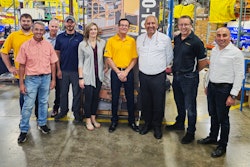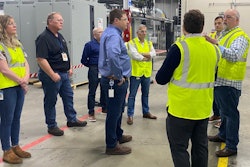
Regardless of its efficiencies in carrying and dumping a load, the efficiency of any kind of hauler is going to be impacted by how easy it is to load. Most often, this is a matter of the loader’s own efficiency. But what about a hauler loading itself?
The earliest self-loading hauler known to this author was the Improved Slusser Excavator, patented in 1866 and built by G. G. Haslup & Bro. of Sidney, Ohio. This machine was a self-loading wagon, modestly described in period sales literature as “The Excelsior of all other Labor-Saving Machines.”
In the 1920s, Highway Trailer Company of Edgerton, Wisconsin, introduced the more direct ancestor to today’s elevating scraper. Highway’s sales literature described it as the “Self-Loading Quick-Action One-Man Operated Rear-Dump Two-Wheel Scraper.” Mercifully for sales and service staff, plus the telegraphers who handled so much of their communication, it was officially the HTS, with a suffix for its three exceptionally large sizes of its time, 2 cubic yards through 5 1/2 cubic yards.
Unlike more conventional competition, it probably could not be run in multiples behind a single tractor. But as that handle noted, it was controlled from the towing tractor, eliminating the cost of a second employee on the scraper(s).
Both the Haslup and Highway machines used a mechanism not unlike that in today’s elevating scraper, a mechanism that picked material from the ground and swept it up into the wagon or scraper. Haslup used a slat conveyor, whereas Highway’s “raker” much more strongly resembled what Gene Hancock perfected in the 1950s.
Thomas Berry is an archivist with the Historical Construction Equipment Association (HCEA). HCEA is a 501(c )3 nonprofit organization dedicated to preserving the history of the construction, dredging and surface mining equipment industries. With over 3,500 members in a dozen countries, its activities include operation of the National Construction Equipment Museum and archives in Bowling Green, Ohio; publication of a quarterly magazine, Equipment Echoes, from which this text is adapted, and hosting an annual working exhibition of restored construction equipment. Individual memberships are $35 within the USA and Canada, and $55 elsewhere. HCEA’s next International Convention and Old Equipment Exposition will be held Sept. 22-24, 2023, in Bowling Green, Ohio. HCEA seeks to develop relationships in the equipment manufacturing industry, and offers a college scholarship for engineering students. Information is available at hcea.net, or by calling 419-352-5616 or emailing [email protected].















![Hcm Ax Landcros Press Release[32] jpg](https://img.oemoffhighway.com/mindful/acbm/workspaces/default/uploads/2025/11/hcmaxlandcros-press-release32jpg.mAEgsolr89.jpg?ar=16%3A9&auto=format%2Ccompress&fit=crop&h=135&q=70&w=240)

